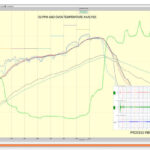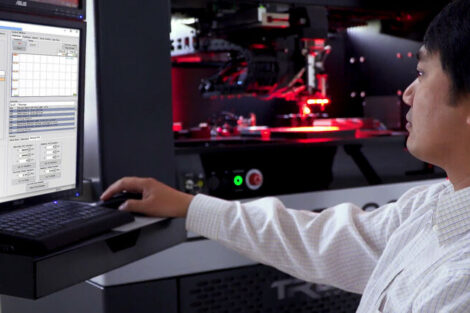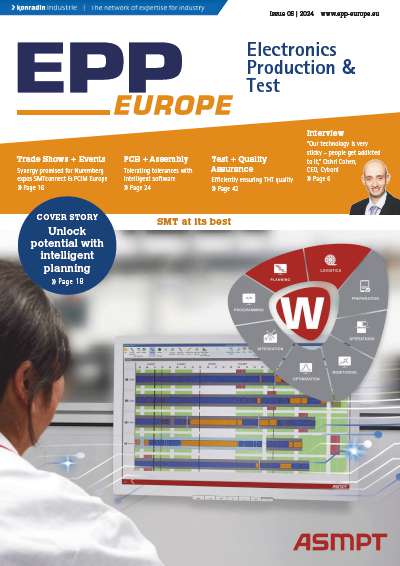Can you tell us a bit about the new tool and its features?
The new O2 version of the Reflow Shuttle is the culmination of a three-year development program. Our initial efforts focused on developing the SLX datalogger, which was launched back in 2022 at Productronica. This device marked a complete redevelopment of our main datalogger, offering enhanced performance, memory, and communication interfaces to measure emerging process parameters within the reflow process.
One of the significant advancements was introducing sensors capable of measuring vacuum levels, temperature profiles, and conveyor speeds. This was followed by vibration sensing within the conveyor system. The final piece of the puzzle was measuring oxygen PPM levels in a nitrogen reflow process. This development took over a year and posed many challenges, but we now have a device that can measure all these parameters in a single pass through the oven.
Why is controlling oxygen levels important in soldering, and how does the new shuttle help with this?
Nitrogen is used in the reflow process for several reasons. Wherever heat and metal surfaces are present, some oxidation will occur. Reducing the oxygen in the process atmosphere helps reduce or slow the level of oxidation. Wetting can also improve with the use of nitrogen, but it‘s not a simple case of the lower the PPM, the better.
To achieve these key benefits, the oxygen level must typically be between 1000 to 500 PPM. However, running levels too low increases nitrogen consumption and can lead to additional process problems. For example, excessively low PPM levels can reduce surface tension too much, causing components to tombstone, which increases costs due to the need for post-reflow rework.
The O2 Reflow Shuttle provides a complete map of the PPM levels as it passes through the oven zones, allowing the PPM levels to be set correctly in the critical areas of the process.
How can the new device impact decision-making and process optimization?
Reflow ovens typically use a single point of measurement for oxygen content, which gives engineers an indication of PPM levels in the process. However, several factors dictate the full performance of a machine when discussing PPM levels. Some ovens use a single nitrogen injection point, for instance, while advanced systems feed nitrogen from the start and end of the process. The O2 Reflow Shuttle shows the performance benefits of each design.
Nitrogen Flow Rate is also a factor. This is the main adjustment for controlling overall PPM levels. Data from the new device allows optimization for least cost consumption while confirming levels required for production specifications. It measures the effects of flow rate adjustments, air curtain designs, and machine-to-machine performance.
Moreover, purging the oven to the desired PPM level is not instantaneous and can take around 20 minutes. The O2 Reflow Shuttle can verify that all specifications are met and that production is ready to start.
Other factors include machine-to-machine differences, reductions in seal tightness resulting in nitrogen leakage, extraction performance changes, and air curtain performance all affect overall process performance concerning oxygen PPM levels. Our new shuttle helps quantify these potential issues.
Can you explain how the monitoring system works and how it integrates into existing oven setups?
The device uses a combination of sensors to bring all key process data into a convenient measurement platform. Traditional thermocouple sensors, combined with specialized instrumentation systems, allow the measurement of advanced process parameters evident in modern reflow soldering.
The O2 PPM capture uses a sensor specifically designed for this application and is paired with a new Solderstar-designed measurement and battery system. All data sensed by the Reflow Shuttle is fed to the main SLX datalogger, which performs all data processing and storage.
Once the Reflow Shuttle exits the oven, data is downloaded to our new analysis software, ‘Process Central’. Engineers are immediately presented with all key process data.
It has two main uses: optimization and understanding of the process, followed by verification of ovens before and during production, and after any machine maintenance. The captured data quickly shows if the process is within specification and helps pinpoint any issues within the oven.
With the ability to precisely monitor and control oxygen levels along with full reflow profiling, the device is setting a new standard for optimizing soldering processes. By eliminating this critical blind spot, electronics manufacturers can improve solder joint quality, reduce defects and costs, and meet the highest reliability standards – even in the most demanding industries.
The comprehensive insight provided allows manufacturers to take their reflow processes to the next level through robust data and analytics. As the imperative for high-density interconnects and miniaturization continues to grow, this degree of control over the soldering environment will become increasingly critical for long-term product performance and reliability.













